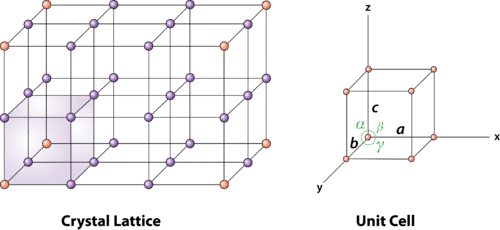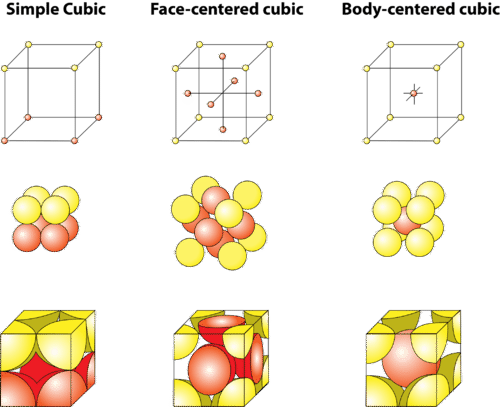13.14 单位单位单元
章节大纲
-
单位单位单位单位单位单位单位单位单位单位单位单位单位单位单位单位单位单位单位单位单位单位单位单位单位单位单位单位单位单位单位单位单位单位单位单位单位单位单位单位单位单位单位单位单位单位单位单位单位单位
How can we measure size of atoms?
::我们如何测量原子的大小?We have many data tables available to us in chemistry . If we wanted to know the size of the lithium , we can easily look it up and find that this atom is 134 picometers across. If we remove the outer , the lithium is now only 90 picometers in size. How do we know this? We don’t have a ruler small enough to measure these tiny distances. But we can use a technique called x-ray diffraction to shine beams of x-rays through a crystal of a lithium . By measuring how much the beams are bent after they come through the crystal, we can calculate the size of the molecule. This technique works both for small materials like lithium compounds and equally well for very large molecules.
::我们有很多化学数据表格可供我们使用。 如果我们想知道锂的大小, 我们可以很容易地查看它, 发现这个原子是134个象仪。 如果我们去除外表, 锂现在只有90个象仪大小。 我们怎么知道呢? 我们没有一个小的标尺可以测量这些小距离。 但是我们可以使用一种叫做X射线分射的技术来通过一个锂晶体来光亮X射线的光束。 通过测量这些原子在通过晶体后弯曲多少, 我们可以计算分子的大小。 这个技术对像锂化合物这样的小材料起作用,对非常大的分子同样有效。Unit Cells
::单位单位单位单位单位单位单位单位单位单位单位单位单位单位单位单位单位单位单位单位单位单位单位单位单位单位单位单位单位单位单位单位单位单位单位单位单位单位单位单位单位单位单位单位单位单位单位单位单位单位单位单位单位单位单位单位单位单位单位单位单位单位单位单位单位单位单位单位单位单位单位单位单位单位单位单位单位单位单位单位单位单位单位单位单位单位单位单位单位单位单位单位单位单位单位单位单位单位单位单位单位单位单位单位单位单位单位单位单位单位单位单位单位单位单位单位单位单位单位单位单位单位单位单位单位单位单位单位单位单位单位单位单位单位单位单位单位单位单位单位单位单位单位单位单位单位单位单位单位单位单位单位单位单位单位单位单位单位单位单位单位单位单位单位单位单位单位单位单位单位单位单位单位单位单位单位单位单位单位单位单位单位单位单位单位单位单位单位单位单位单位单位单位单位单位单位单位单位单位单位单位单位单位单位单位单位单位单位单位单位单位单位单位单位单位单位单位单位单位单位单位单位单位A unit cell is the smallest portion of a crystal lattice that shows the three-dimensional pattern of the entire crystal. A crystal can be thought of as the same unit cell repeated over and over in three dimensions. Figure illustrates the relationship of a unit cell to the entire crystal lattice.
::单体电池是晶体板中最小的部分,显示整个晶体的三维图案。一个晶体可以被视为在三个维度中反复重复的同一个单元。图中显示了单体电池与整个晶体板之间的关系。A unit cell is the smallest repeating portion of a crystal lattice.
::单细胞是晶体层中最小的重复部分。Unit cells occur in many different varieties. As one example, the cubic crystal system is composed of three different types of unit cells: (1) simple cubic , (2) face-centered cubic , and (3) body-centered cubic . These are shown in three different ways in Figure .
::例如,立方晶体系统由三种不同类型的单元细胞组成1) 简单的立方体,(2) 面向面的立方体,(3) 以身体为中心的立方体。图3以三种不同方式显示。
Three unit cells of the cubic crystal system. Each sphere represents an atom or an ion. In the simple cubic system, the atoms or ions are at the corners of the unit cell only. In the face-centered unit cell, there are also atoms or ions in the center of each of the six faces of the unit cell. In the body-centered unit cell, there is one atom or ion in the center of the unit cell in addition to the corner atoms or ions.
::立方晶体系统的三个单位单元格。 每个球体代表原子或离子。 在简单的立方系统中, 原子或离子只位于单元单元格的角。 在以脸为中心的单元单元格中, 单元单元格的六个面的每个面的中间都有原子或离子。 在以身体为中心的单元单元格中, 除了角原子或离子之外, 单元单元格的中心还有一个原子或离子。Pay special attention to the last diagram for each type of cell. You will notice that the atoms or ions at the edges of each face or at the corners are not complete spheres. In the simple cubic cell, each corner atom is shared by 8 differenent unit cells. The same situation exists for the edge or corner particles in the face-centered and body-centered cubic forms. In addition, each of the particles in the center of the face-centered cubic cell is shared by 2 unit cells. Body-centered cells have an additional atom in the middle of the cell which is contained entirely in that cell.
::特别注意每种类型的单元格的最后图表。 您将会注意到, 每个脸部边缘或角角的原子或离子并不是完整的球体。 在简单的立方单元格中, 每个角的原子由8个不同的单位单元格共享。 以脸为中心的和以身体为中心的立方形态中的边缘或角颗粒也存在同样的情况。 此外, 以脸为中心的立方单元格中心的每个粒子由两个单位单元格共享。 以身体为中心的单元格在完全包含在该单元格的单元格中间有一个额外的原子。Note that we have only considered the unit cells of a cubic crystal. Other crystal forms also have unit cells. These unit cells are listed below:
::请注意,我们只考虑过立方体晶体的单元细胞,其他晶体也含有单元细胞。-
rhombohedral, hexagonal, triclinic – one unique form each
::Rhombohedral、六边形、三科门诊 — — 每种独特的形式 -
tetragonal – simple and body-centered
::四边形 — — 简单而以身体为中心的 -
monoclinic – simple and base-centered
::简单而以基础为中心的单一诊所 -
orthorhombic – simple, face-centered, body-centered, base-centered
::简单、以脸为中心、以身体为中心、以基点为中心
Summary
::摘要-
A unit cell is the smallest portion of a crystal lattice that shows the three-dimensional pattern of the entire crystal.
::单体电池是晶体板的最小部分,显示整个晶体的三维图案。 -
There are three different types of unit cells in the cubic crystal system.
::立体晶体系统中有三种不同类型的单元细胞。
Review
::回顾-
What is a unit cell?
::什么是单细胞? -
List the three cubic unit cells.
::列出三个立方单元的细胞。 -
Does each unit cell exist as an entity by itself?
::每个单位单元是否本身就作为一个实体存在?
-
rhombohedral, hexagonal, triclinic – one unique form each


